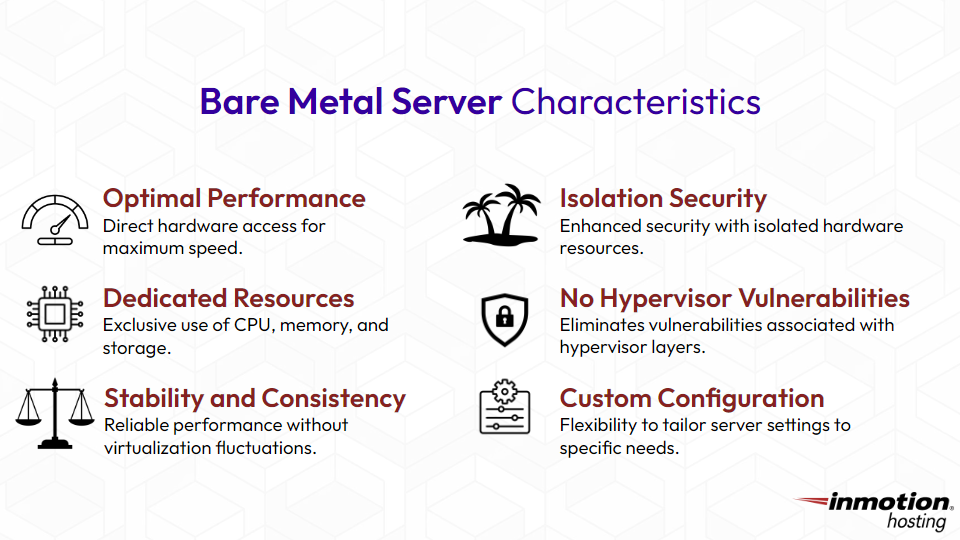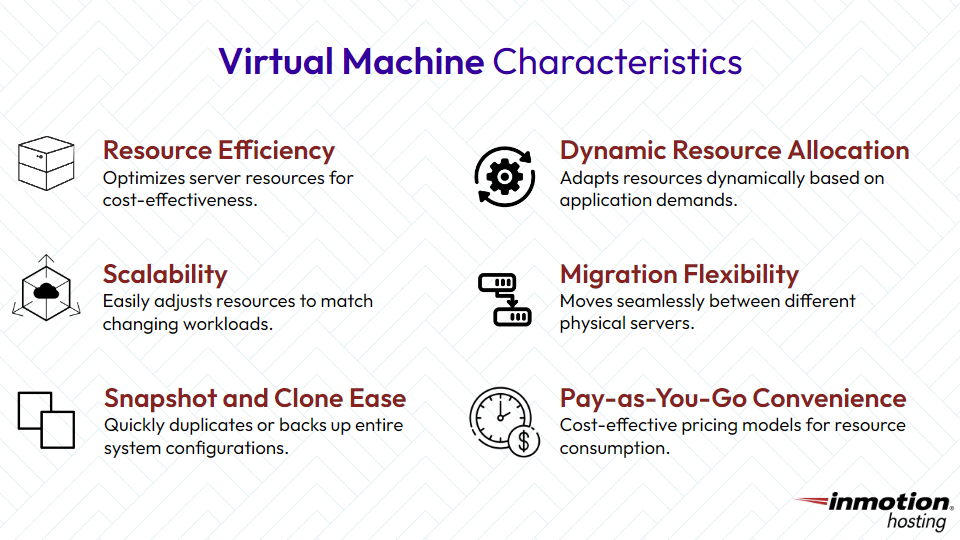
The choice between bare metal servers and virtual machines can be an important decision for businesses and IT professionals. Each approach comes with its own set of advantages and trade-offs, influencing performance, scalability, and resource utilization.
In this article, we’ll first discuss exactly what bare metal servers are and what virtual machines are.
Next, we’ll compare and contrast the following characteristics:
Finally, we’ll cover how to choose between bare metal and virtual machines.
What is a bare metal server? Bare metal servers, often referred to as dedicated servers or physical servers, represent a traditional form of hosting where an entire physical server is dedicated to a single user or organization. Unlike virtual machines, which run on a hypervisor layer, bare metal servers have direct access to the underlying hardware.
Key Characteristics of Bare Metal Servers
Performance
One of the primary advantages of bare metal servers is their superior performance. With direct access to physical resources, there is no overhead from a hypervisor, allowing applications to utilize the full power of the server’s CPU, memory, and storage.
Bare metal servers provide a high level of isolation, making them suitable for applications that demand dedicated resources and stringent security measures. This isolation also mitigates the “noisy neighbor” effect, where the performance of one virtual machine can be impacted by the activities of others on the same physical host.
Customization
Users have complete control over the server’s configuration, enabling customization to meet specific requirements. This flexibility is advantageous for workloads with unique resource needs or specialized hardware requirements.
Predictable Performance
Since there is no virtualization layer, the performance of bare metal servers remains consistent. This predictability is crucial for applications with demanding performance criteria, such as high-frequency trading or real-time processing.
Use Cases for Bare Metal Servers
High-Performance Applications
Bare metal servers are ideal for applications that demand maximum computational power, such as data analytics, scientific simulations, and rendering.
Database Servers
Database workloads benefit from the dedicated resources and predictable performance of bare metal servers, ensuring efficient data processing and retrieval.
Security-Sensitive Applications
Industries with strict security and compliance requirements, such as finance and healthcare, often opt for bare metal servers to maintain control over their infrastructure and data.
Resource-Intensive Workloads
Workloads requiring substantial computing resources, such as machine learning training or video transcoding, can leverage the full capacity of bare metal servers.
Understanding Virtual Machines
What are virtual machines? Virtual machines (VMs) are software-based instances that emulate the functionality of a physical computer. They operate on a hypervisor, a layer of software that abstracts and manages the underlying hardware, allowing multiple VMs to coexist on a single physical server.
Key Characteristics of Virtual Machines

Resource Consolidation
Virtualization enables the efficient utilization of physical resources by running multiple VMs on a single server. This consolidation leads to improved resource efficiency and cost savings.
Scalability
VMs offer a high degree of scalability, allowing organizations to dynamically allocate or deallocate resources based on demand. This flexibility is particularly beneficial for applications with variable workloads.
Snapshot and Cloning
Virtual machines can be easily cloned or snapshots can be created, providing a quick and efficient way to duplicate or backup entire system configurations. This feature enhances disaster recovery capabilities and simplifies the deployment of new instances.
Hardware Independence
VMs abstract the underlying hardware, making them hardware-independent. This abstraction facilitates migration between different physical servers without requiring modifications to the virtualized environment.
Use Cases for Virtual Machines
Server Consolidation
Virtualization is highly effective for consolidating multiple workloads onto a single physical server, reducing hardware costs and improving resource utilization.
Development and Testing
Virtual machines provide an isolated and reproducible environment for development and testing purposes. Developers can create and test applications without affecting the production environment.
Multi-Tenancy
Virtualization enables the hosting of multiple virtual machines on a single physical server, making it suitable for environments where different users or organizations share the same infrastructure.
Legacy Application Support
Virtualization allows organizations to run legacy applications on modern hardware, extending the lifespan of critical software that may not be compatible with the latest hardware.
Comparing Performance and Resource Utilization
Performance Considerations for Bare Metal Servers
- Raw Performance: Bare metal servers offer unparalleled raw performance, as there is no virtualization layer introducing overhead. This makes them well-suited for applications that require maximum computational power.
- I/O Performance: With direct access to physical resources, bare metal servers often exhibit superior I/O performance compared to virtual machines. This is crucial for workloads with high disk or network activity.
- Latency: Applications sensitive to latency, such as real-time processing or high-frequency trading, benefit from the low-latency environment of bare metal servers.
Resource Utilization in Virtual Machines
- Efficiency: Virtual machines excel in resource utilization, allowing multiple workloads to share a single physical server. This efficiency reduces hardware costs and energy consumption.
- Dynamic Scaling: Virtual machines provide the ability to dynamically allocate or deallocate resources based on demand. This scalability is advantageous for applications with fluctuating workloads.
- Isolation: While virtualization provides isolation between VMs, it introduces a layer of abstraction that can impact performance. The “noisy neighbor” effect, where one VM influences the performance of others on the same host, is a consideration.
Management and Flexibility
Management of Bare Metal Servers
- Direct Control: Administrators have direct control over the entire server, facilitating management tasks such as hardware upgrades, firmware updates, and kernel modifications.
- Resource Allocation: Since resources are dedicated, there is no contention for CPU, memory, or storage among multiple users or applications. This simplicity can ease troubleshooting and performance optimization.
- Single-Tenancy: Bare metal servers are inherently single-tenant, providing a dedicated environment for an organization’s exclusive use. This enhances security and compliance capabilities.
Management of Virtual Machines
- Resource Allocation and Overcommitment: Virtual machines allow for dynamic resource allocation, but administrators must carefully manage resources to prevent overcommitment, which can lead to degraded performance.
- Hypervisor Management: Administrators need to manage the hypervisor layer, including updates, patches, and configurations. This additional layer introduces complexity but offers the benefit of resource optimization.
- Multi-Tenancy: Virtualization allows for the hosting of multiple VMs on a single physical server, enabling multi-tenancy. This shared environment can lead to challenges in resource allocation and performance isolation.
Security Implications
Security on Bare Metal Servers
- Isolation: Bare metal servers provide strong isolation, reducing the risk of security breaches due to shared resources. This makes them suitable for applications with stringent security requirements.
- Physical Access: Since bare metal servers are physical machines, physical access to the server is a security consideration. Data center security and access controls become crucial in preventing unauthorized access.
- Custom Security Measures: Organizations can implement custom security measures tailored to their specific needs, enhancing the overall security posture of bare metal environments.
Security in Virtual Machines
- Isolation Challenges: While virtualization provides a level of isolation, vulnerabilities at the hypervisor layer could potentially lead to security risks. Mitigating these risks requires robust hypervisor security measures.
- Shared Environment: Virtual machines operate in a shared environment, raising concerns about the “escape” of malicious activity between VMs on the same host. Strong access controls and security configurations are essential.
- Security Updates: Regular updates to the hypervisor and virtual machine images are critical to address security vulnerabilities. Timely patching and maintenance are essential components of a secure virtualization environment.
Cost Considerations
Cost of Bare Metal Servers
- Upfront Costs: Bare metal servers typically involve higher upfront costs, as users are paying for exclusive access to physical hardware.
- Total Cost of Ownership (TCO): While the initial investment is higher, the TCO may be lower for certain workloads that demand consistent high performance over an extended period.
- Scalability Costs: Scaling with bare metal servers involves provisioning additional physical hardware, which can be more expensive than scaling with virtual machines.
Cost of Virtual Machines
- Resource Efficiency: Virtual machines allow for efficient resource utilization, enabling users to run multiple workloads on a single physical server. This leads to cost savings in terms of hardware expenses and energy consumption.
- Scalability Benefits: Scaling with virtual machines is more cost-effective, as users can add or remove instances dynamically based on demand. This flexibility aligns well with variable workloads.
- Pay-as-You-Go Models: Cloud providers often offer pay-as-you-go pricing models for virtual machines, allowing users to pay only for the resources they consume. This cost structure is favorable for businesses with fluctuating workloads.
Making the Right Choice
Factors Influencing the Decision
- Performance Requirements: Consider the performance demands of your applications. If they require maximum raw performance and minimal latency, bare metal servers may be the preferred choice.
- Scalability Needs: Evaluate the scalability requirements of your workloads. If you anticipate variable workloads and need the flexibility to scale resources up or down quickly, virtual machines might be a better fit.
- Resource Efficiency: Assess the efficiency of resource utilization. If you aim to maximize resource efficiency and reduce costs through consolidation, virtual machines are a compelling option.
- Security and Compliance: Consider your organization’s security and compliance requirements. If you need strong isolation and control over the entire infrastructure, bare metal servers may align better with your needs.
- Budget Constraints: Evaluate your budget constraints and preferences. If upfront costs are a concern and you prefer a pay-as-you-go model, virtual machines, especially in cloud environments, offer a more cost-effective approach.
Hybrid Approaches
- Combining Bare Metal and Virtual Machines: Some organizations adopt hybrid approaches, using bare metal servers for performance-critical workloads and virtual machines for less resource-intensive tasks. This hybrid strategy leverages the strengths of each approach.
- Containerization: Container technologies, such as Docker and Kubernetes, provide a lightweight alternative to virtualization. Containers offer isolation similar to virtual machines but with lower overhead. Consider containerization for applications that benefit from fast deployment and scaling.
The Future Landscape
As technology continues to evolve, new paradigms such as edge computing, serverless architectures, and advanced containerization technologies are shaping the future of IT infrastructure. Organizations must stay abreast of these developments to make informed decisions that align with their business goals.
Conclusion
The choice between bare metal servers and virtual machines is a nuanced decision that depends on the specific needs, goals, and constraints of an organization. Bare metal servers offer unparalleled performance, security, and control, making them suitable for applications with stringent requirements. On the other hand, virtual machines excel in resource efficiency, scalability, and cost-effectiveness, making them a popular choice for diverse workloads, especially in cloud environments.
Ultimately, the optimal solution may involve a combination of both approaches or the integration of emerging technologies such as containerization. By carefully evaluating the performance, management, security, and cost considerations outlined in this article, organizations can make informed decisions that pave the way for a resilient and scalable IT infrastructure.







